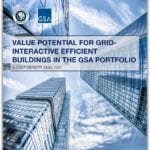Unlock the Untapped Value in Your Building Today
 Rocky Mountain Institute (RMI) recently launched a report on the “Value Potential for Grid-Interactive Efficient Buildings in the GSA Portfolio: A Cost-Benefit Analysis.” The report delves into strategies grid-interactive building (GEB) owners can use to “unlock “ savings in costs, energy, and carbon by allowing their buildings to communicate with the electric grid.
Rocky Mountain Institute (RMI) recently launched a report on the “Value Potential for Grid-Interactive Efficient Buildings in the GSA Portfolio: A Cost-Benefit Analysis.” The report delves into strategies grid-interactive building (GEB) owners can use to “unlock “ savings in costs, energy, and carbon by allowing their buildings to communicate with the electric grid.
Not only is there significant money left on the table by building owners, but there is substantial environmental upside to be had as well.
However, to effectively balance the grid, system operators must have assistance from building owners.
Buildings are essential to balancing the grid—they drive as much as 80% of peak demand!
At THG, we are well aware 20-30% of your electric costs are based on the consumption of electricity in just four or five hours across an entire summer season. This cost is tied to “peak demand.” However, RMI has found that peak demand can account for as much as 60% of a commercial building’s energy cost. Let’s say that again:
Peak demand can account for up to 60% of a commercial building’s energy costs!
RMI sees much work to be done around controls integration, interoperability, pricing schemes for buildings and the grid, and a fundamental paradigm shift in energy management from traditional demand response to strategic focus that manages demand and the time value of energy. Although we can agree that there is much work to be done around system interoperability, standards, and demand-focused optimization, our ADRC enables you to use your buildings’ assets to start unlocking value from market-based demand management now.
RMI champions the reason why consistent demand management is needed to reduce peaks and maximize load flexibility. The full value of demand management comes from not just participating in capacity programs, but in leveraging diversified demand strategies such as Time of Use (TOU) rates, critical peak demand pricing, a grid-interactive marketplace, energy efficiency, and other measures. While there are still strides to be made in these areas in regulated markets across the US, our clients in ISOs such as CAISO, ERCOT, PJM, NY ISO, and ISO-NE can participate in a variety of demand management programs on offer because of the industry-leading flexibility our ADRC (Automated Demand Response Controller).
Our ADRC facilitates bi-directional communication with grid and employs automated load adjustment strategies to your existing building controls. This allows building owners to extract the maximum value from market-based demand management without necessarily investing in an updated building controls system. This value only grows as buildings apply retrofit efficiency projects and system operators expand the program opportunities and incentives available for GEBs.
Learn more about how you can unlock building value now using our ADRC: ContactUs@thgenergy.com.
Recommended Reading & Resources:
The Opportunity to Save Money, Energy, and Carbon With Grid-Interactive Efficient Buildings by Matt Jungclaus at Rocky Mountain Institute
Value Potential for Grid-Interactive Efficient Buildings in the GSA Portfolio: A Cost-Benefit Analysis by Cara Carmichael, Matt Jungclaus, Phil Keuhn, and Kinga Porst Hydras at Rocky Mountain Institute

